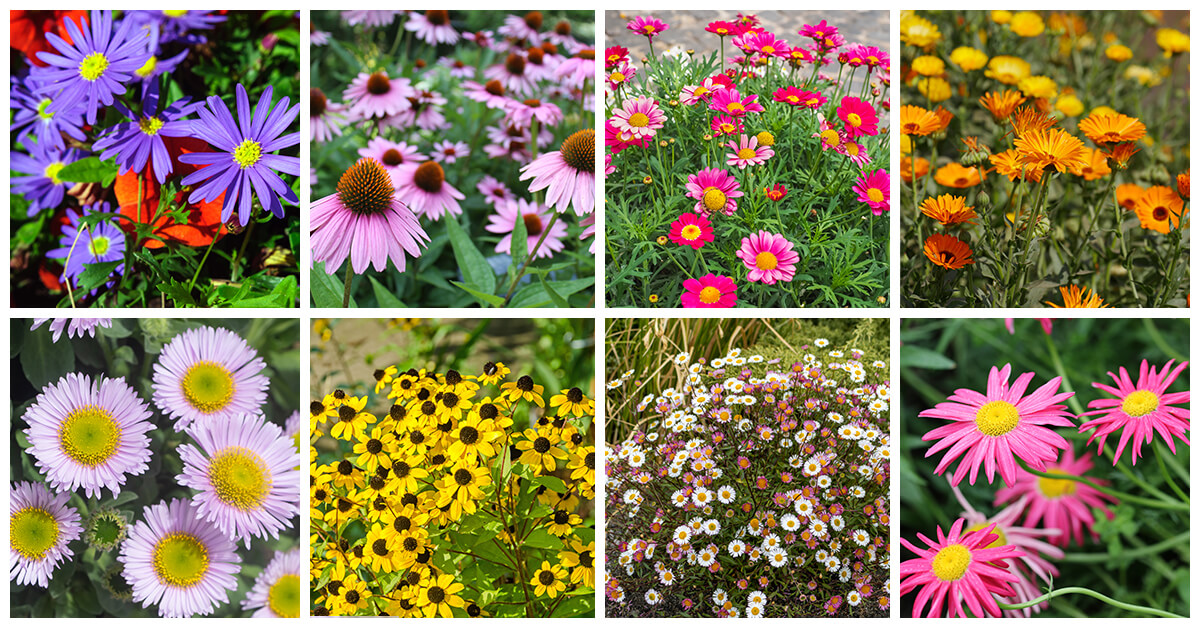Daisy flowers are famous for their bright colors, ease of care, and long-blooming season. They are perfect for naturalizing your yard, adding to a vase, or even making a bouquet. Planting daffodils is simple, and the flowers are drought-tolerant and self-seeding. However, not all daffodils are created equal. There are several varieties of daffodils with varying traits.
27 Chic, Glorious, and Versatile Exotic Dainty Florals with Vibrant hues for All Seasons
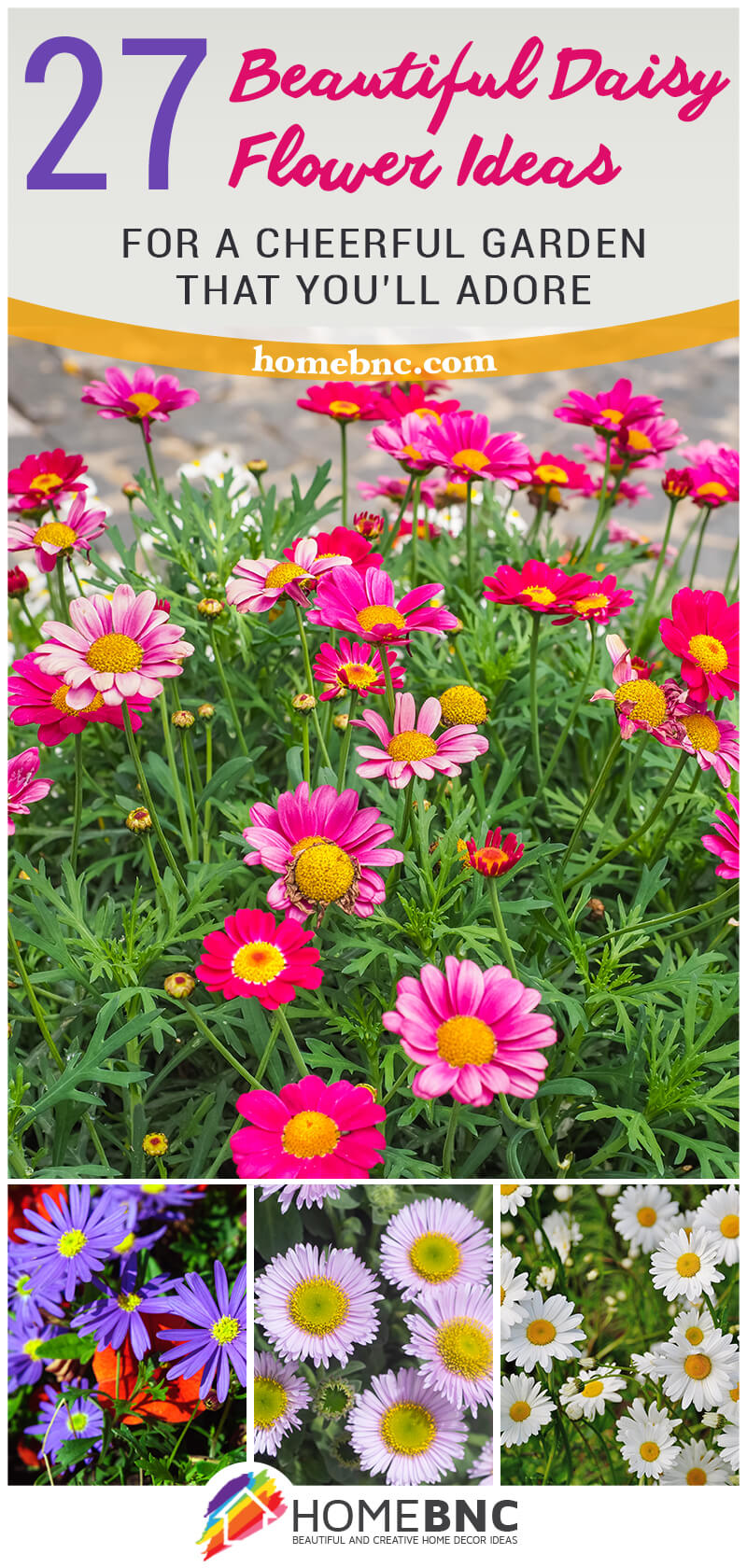
Looking out your window and seeing various types of daisy flowers is probably one of spring’s first things to mind. They are everywhere, and they make us happy. There is no denying that the daisy is one of the most recognizable flowers of the Season. They come in so many different varieties and meanings. Daffodils are used for spring bouquets, table centerpieces, and floral decorations. The bright colors make them perfect for weddings, Valentine’s Day, Easter, and Mother’s Day. They also make great houseplants because they’re easy to look after.
1. English Daisy (Bellis Perennis)
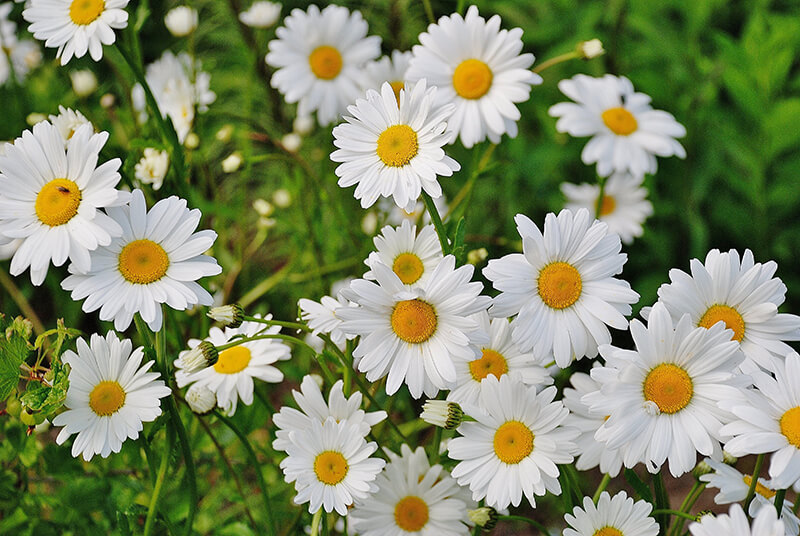
- 🔮 Symbolism: Innocence and purity
- 💧 Water needs: Regular watering, avoid soggy soils
- 🪴 Soil needs: Cool, moist loamy soil with a Ph range of acidic to alkaline
- 🌍 Growing zones: 4 to 8
- ☀️ Light needs: Full, dappled shade
- 🌱 Blooming season: Spring, early summer
The English daisy has a biennial life cycle. The flowers have a yellow disk at the center surrounded by white, pink, or red brightly colored petals. Most pictures of daisy flowers show them as sparkly, the kind that can add color to a dull. They are also called lawn daisies or European daisies. They fold their petals at night and open them with the rising sun. Sow seeds of English daisy in spring or early fall. Transplanting the daisy flower plants is not recommended.
2. Gerbera Daisy (Gerbera Jamesonii)
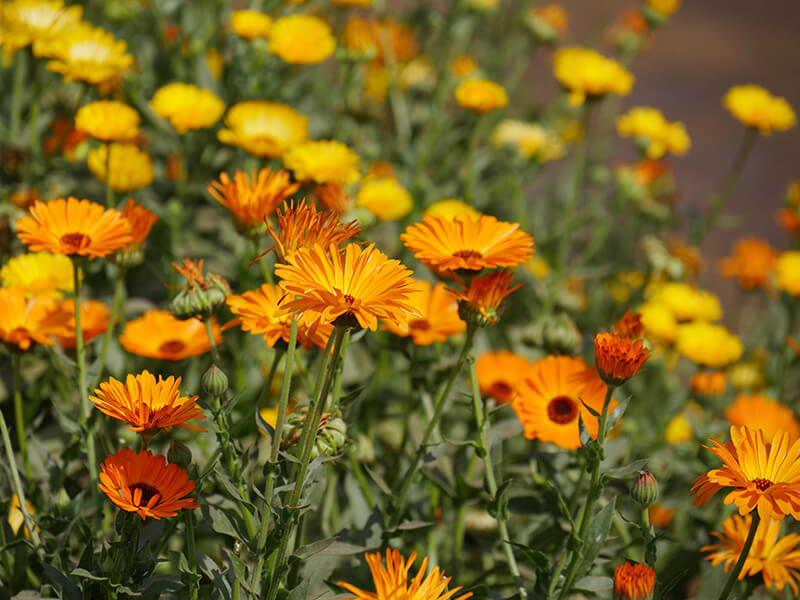
- 🔮 Symbolism: Fertility, purity, innocence, and beauty
- 💧 Water needs: Frequent watering
- 🪴 Soil needs: Moist, well-drained, Neutral to acidic, compost rich
- 🌍 Growing zones: 8 to 11
- ☀️ Light needs: Full sun
- 🌱 Blooming season: Early spring through fall
Gerbera Daisy’s plant flowers are brightly colored, which makes them surreal. The different kinds of brightly colored flowers make eye candy from their growth. You can enjoy their splendor from spring through autumn. Gerbera daisies can add color to your indoors. Pot the plants by the window sill so they can receive maximum sunlight. In addition, you can grow them on your lawns. For a colorful summer dinner, toss a few tops of these daises in a water body to add more flavor to the eyes.
3. Marguerite Daisy (Argyranthemum Frutescens)
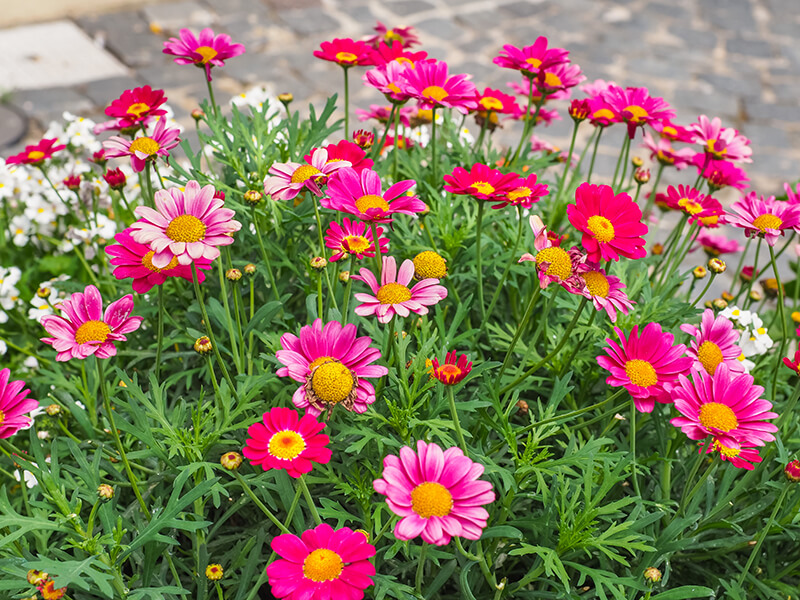
- 🔮 Symbolism: New beginnings, hope, innocence, fun
- 💧 Water needs: Regular watering, avoid soggy soils
- 🪴 Soil needs: Moist, well-drained, neutral to acidic, rich compost
- 🌍 Growing zones: 9 to 11
- ☀️ Light needs: Full sun
- 🌱 Blooming season: Late spring, early fall
Marguerite Daisy is a perennial herbaceous plant that can be a nice addition to flower beds, borders, and containers. Since the flower can grow in full and partial sun, it makes a great addition to indoor decor. There are different daises from this family. To choose the one that suit you, look at the pictures of daisy flowers online for the difference. The flashy petals with a yellow center bloom are excellent as cut flowers, house flowers, or garden plants.
4. Oxeye Daisy (Leucanthemum Vulgare)
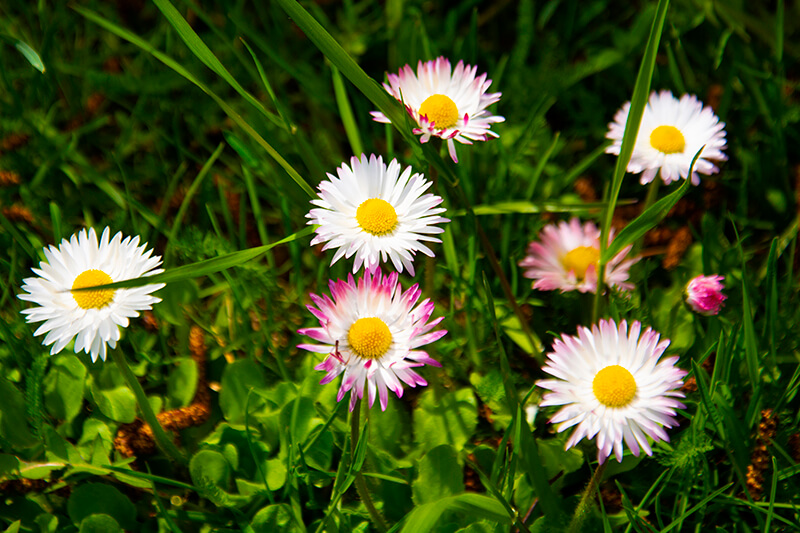
- 🔮 Symbolism: Patience and fertility
- 💧 Water needs: Low, average watering
- 🪴 Soil needs: Well-drained soils, mildly acidic to neutral
- 🌍 Growing zones: 3 to 8
- ☀️ Light needs: Full, dappled shade
- 🌱 Blooming season: May through August
Oxeye daisies not only serve aesthetical value but can be used as food. Its roots and leaves are used to brew herbal tea. In addition, the leaves can be used for salads and stews. You would prefer Oxeye daisy if you are living in the dry parts. It forms an excellent ground cover. The flower exudes a cheerful and mystical aura with its colorful petals.
5. Painted Daisy (Tanacetum Coccineum)

- 🔮 Symbolism: Immortality
- 💧 Water needs: Regular watering. Avoid soggy soils.
- 🪴 Soil needs: Well-drained, moist, and sandy to loamy soils, acidic
- 🌍 Growing zones: 3 to 7
- ☀️ Light needs: Full, partial sun
- 🌱 Blooming season: Late spring to mid summer
Painted daises are bright flowers ideal for borders, rocky gardens, and lawns. The flowers have an anti-pest factor and thus do not need to be sprayed. Ideally, you can use the flowers along borders to protect other plants from pests because they are a natural barrier. Pictures of these daisy flowers might look similar due to shared family. Be careful to pick the exact daisy while ordering. Painted daises offer an enchanting exquisite and distinctive aura.
6. Shasta Daisy (Leucanthemum x Superbum)
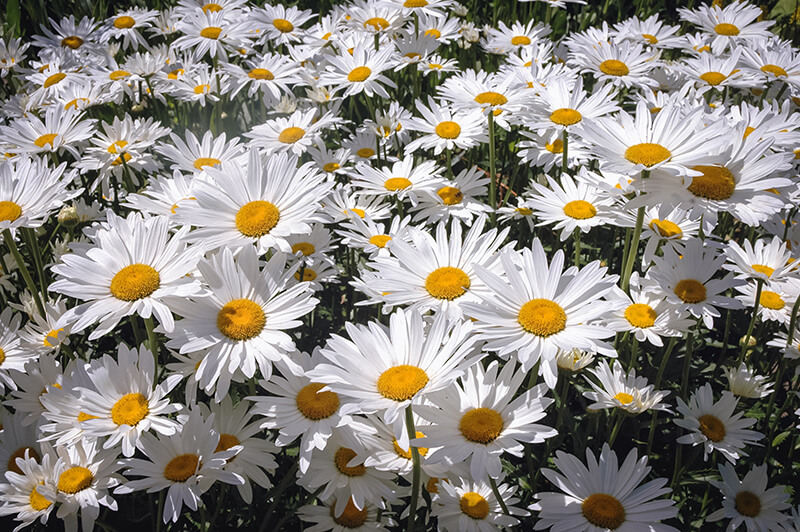
- 🔮 Symbolism: Purity, innocence
- 💧 Water needs: Low to moderate water requirements
- 🪴 Soil needs: Well-drained, neutral, moist, medium rich loamy
- 🌍 Growing zones: 4 to 9
- ☀️ Light needs: Full sun
- 🌱 Blooming season: Summer
With the right conditions for growth, these types of daises require minimum care. Becky Shasta daisies are most commonly used for borders, mixed flower beds, and cutting gardens. Their spectacular and vibrant nature with sparkly petals serves as eye candy.
7. Swan River Daisy (Brachyscome Iberidifolia)
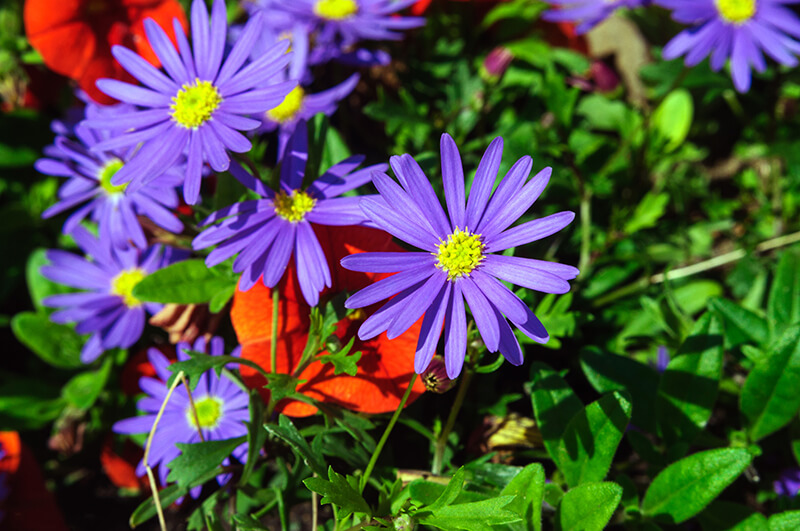
- 🔮 Symbolism: Innocence and purity
- 💧 Water needs: Low to moderate
- 🪴 Soil needs: Rich, well-drained and moist, slightly acid to alkaline
- 🌍 Growing zones: 2 to 8
- ☀️ Light needs: Full sun
- 🌱 Blooming season: June, July, August, September, October, November
Swan River Daisy (Brachyscome iberidifolia) is a hardy herbaceous plant that can be grown annually and perennially. The brightly colored petals are eye candy when grown together. They are a popular choice for gardens, as a border plant, or in pots and containers. Decide on swan waterway daisies while establishing holders since they will flow alluringly over the sides; they likewise make a show at the front of bloom beds and as a line plant, framing low mats of variety along a walkway. The bluish and violet blossoms offer an unforgettable striking sight. With their soft-textured foliage and dainty blossoms, swan river daisies make a colorful addition to the garden.
8. Pale Purple Coneflower (Echinacea Pallida)
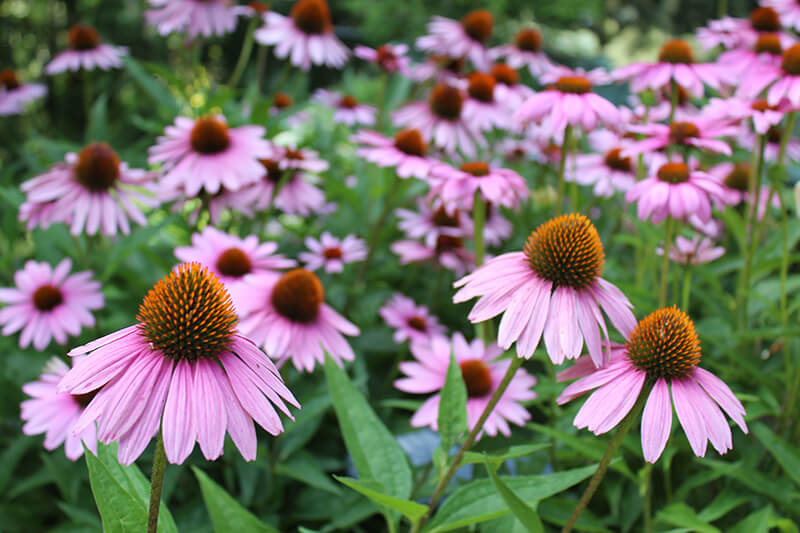
- 🔮 Symbolism: Strength and healing
- 💧 Water needs: Low to moderate
- 🪴 Soil needs: Well-drained, neutral, alkaline, or acidic, sandy, loamy, or clay
- 🌍 Growing zones: 3 to 10
- ☀️ Light needs: Full, dappled shade
- 🌱 Blooming season: June, July, August, September
Pale Purple Coneflower is a good choice for prairies and landscapes. It is perfect for wildflower gardens, beds, borders meadows, and cottage gardens. You can plant the flower for medicinal purposes because its leaves and flowers are edible and have been used for tinctures. In addition, the images of daisy flowers from this family show eye candy. The purple flower transforms our gardens into a sea of purple and pink seasonal, showy and radiant blossoms.
9. Common Fleabane (Erigeron Philadelphicus)
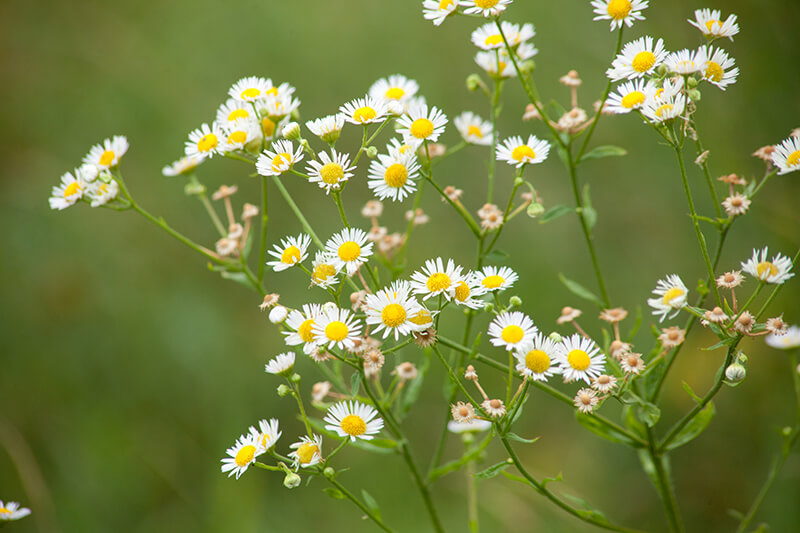
- 🔮 Symbolism: Purity and innocence
- 💧 Water needs: Moderate watering
- 🪴 Soil needs: Fertile and moist, Alkaline, fertile black loam, clay, gravel
- 🌍 Growing zones: 2 to 7
- ☀️ Light needs: Full sun, partial shade
- 🌱 Blooming season: May to June
They additionally look extraordinary, complemented by in-cabin gardens, knolls, rock gardens, blossom bed borders, and other naturalized regions. The beautiful circle blossoms of the fleabane are pretty to take a gander at and draw in pollinators like butterflies and thus are utilized in pollinator gardens. The leaves and different pieces of the plant are utilized to make tea. This creation has diuretic, astringent, diaphoretic, and emmenagogue properties; thus, treating different ailments is utilized. The radially symmetrical flowering structure has a wide, bright yellow, central disk surrounded by short, petal-like dreamy, contemporary, and dazzling white rays.
10. Seaside Daisy (Erigeron Glaucus)
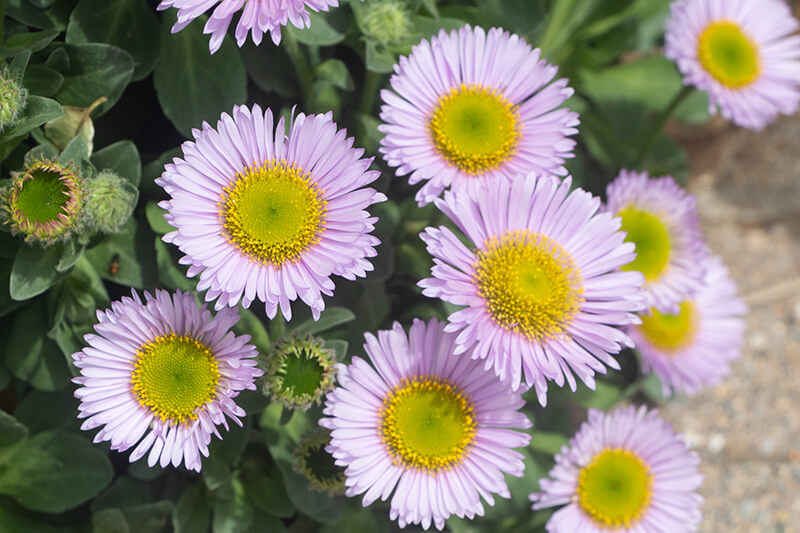
- 🔮 Symbolism: Childhood, innocence and purity
- 💧 Water needs: Moderate
- 🪴 Soil needs: Acidic, alkaline, neutral, moist, well-drained
- 🌍 Growing zones: 8 to 10
- ☀️ Light needs: Full, dappled shade
- 🌱 Blooming season: March to November
The Seaside Fleabane is famously utilized in the butterfly garden, waterfront garden, rock garden, borders, beds, along the inclines, and pots and compartments. It additionally functions admirably for xeriscaping, however, thrives best in areas with significant seepage and along the ocean side. Its chic, bold and enchanted look is appalling. These plants are also reasonable to develop on top of dividers for banks, rockeries, and different assortments.
11. Coneflower ‘Hope’ (Echinacea Purpurea)
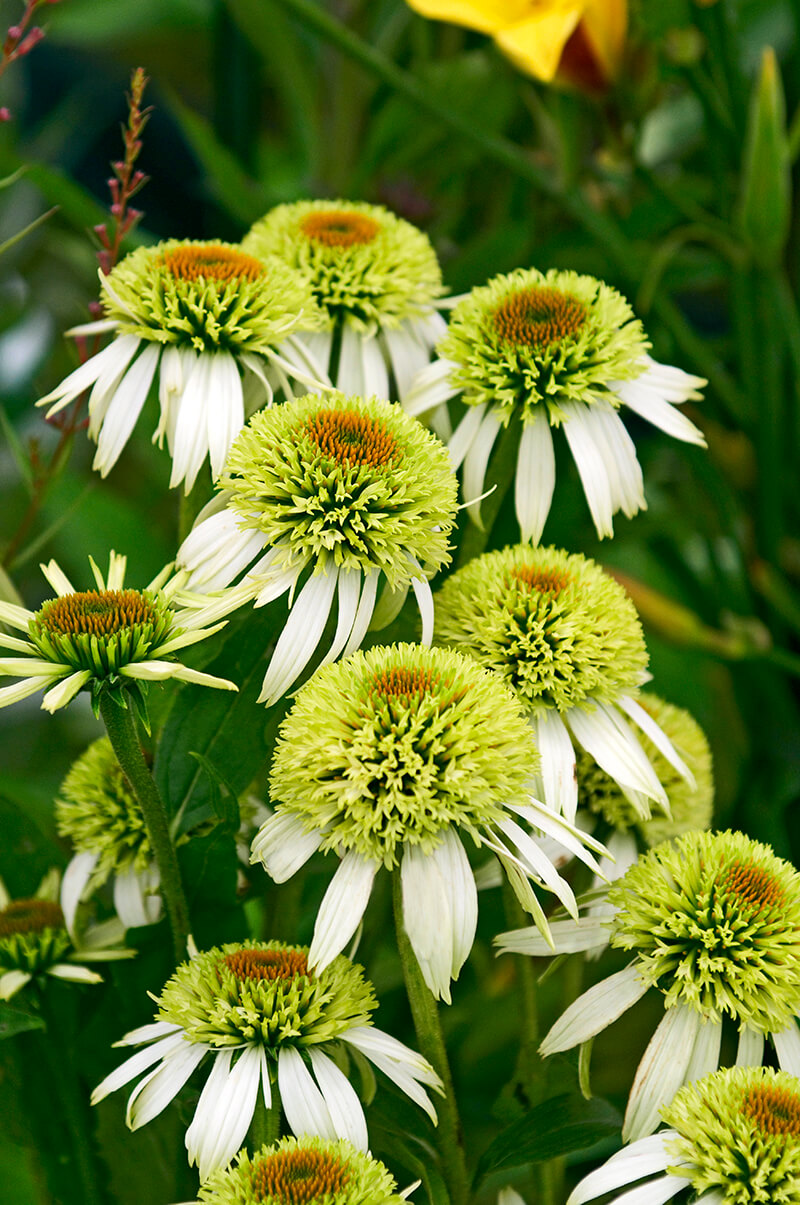
- 🔮 Symbolism: Strength and healing
- 💧 Water needs: Average
- 🪴 Soil needs: Well-drained, moist, chalk, loam, sand, Neutral, acidic, alkaline
- 🌍 Growing zones: 4 to 10
- ☀️ Light needs: Full sun
- 🌱 Blooming season: July to October
The mauve shade of purple gives these flowers an enchanting chic appearance. They are a great attraction for bees, birds, and hummingbirds adding more décor to your garden. Their lush blooms are perfect for lawns, gardens, patios, and containers.
12. Black-Eyed Susan ‘Indian Summer’ (Rudbeckia Hirta)
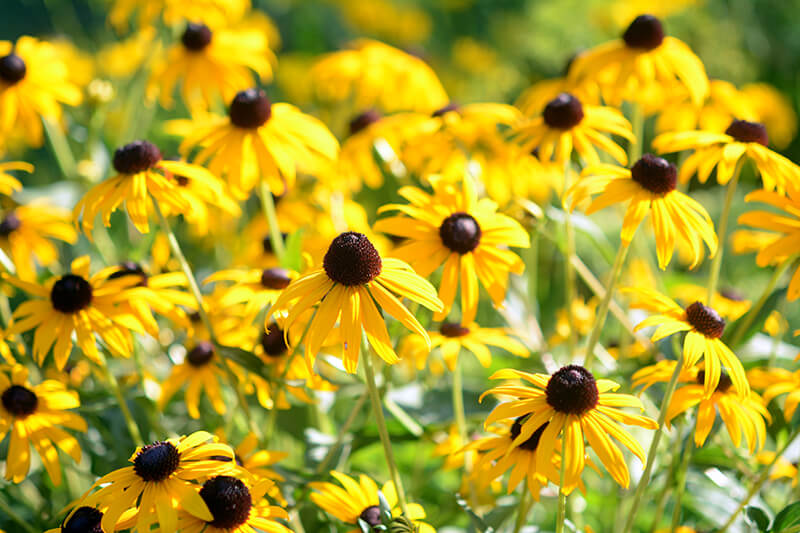
- 🔮 Symbolism: Resilience, endurance, and survival
- 💧 Water needs: Average
- 🪴 Soil needs: Well-drained, moist, neutral, alkaline, acidic
- 🌍 Growing zones: 3 to 7
- ☀️ Light needs: Full sun, partial shade
- 🌱 Blooming season: Summer until the first frost
The bright-colored flower is an excellent addition to your garden. It attracts both bees and butterflies, making your garden lovelier. The seeds are poisonous, but the roots have been widely used in the cosmetic industry. The magnificent, luminous, and oversized flowers offer a chic appearance. Blue-eyed Susan can be cuttings in gardens, prairies, meadows, and cottages.
13. Mexican Fleabane (Erigeron Karvinskianus)
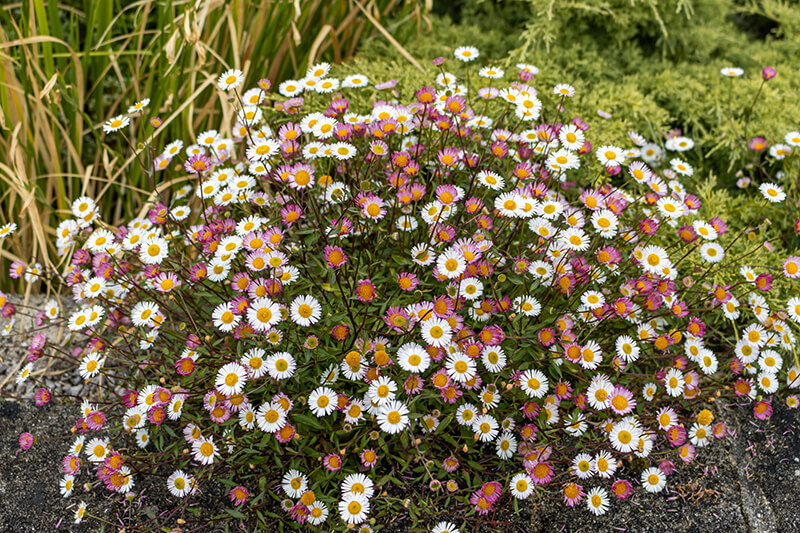
- 🔮 Symbolism: Childhood innocence, simplicity, and joy
- 💧 Water needs: Moderate
- 🪴 Soil needs: Well-drained, neutral, alkaline, acidic, chalk, loam, sandy, clay
- 🌍 Growing zones: 5 to 9
- ☀️ Light needs: Full sun
- 🌱 Blooming season: March to November
The Mexican daisy is versatile in the way it can be planted. It can be used for perimeter lining for garden beds, buried behind small retaining walls to cascade over edges, or simply planted in pots and enjoy its blooms. The complementary, color-infused and farm-fresh flower has a great smell to tickle your smell nerves.
14. Brown-eyed Susan (Rudbeckia Triloba)
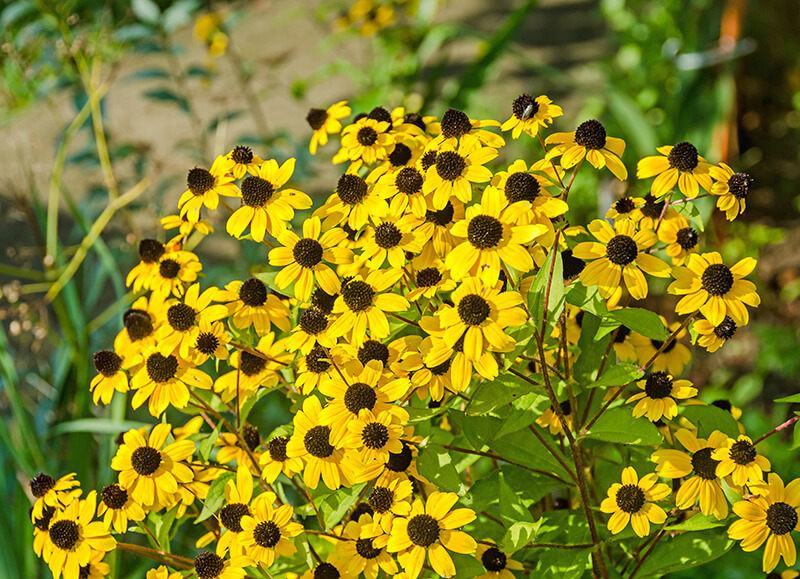
- 🔮 Symbolism: Protection against evil spirits and sickness
- 💧 Water needs: Average
- 🪴 Soil needs: Well-drained, neutral to alkaline, fertile loam, clay, gravel
- 🌍 Growing zones: 4 to 8
- ☀️ Light needs: Full sun
- 🌱 Blooming season: May to October
This daisy can be successfully planted in meadows, prairies, fields, or gardens. The gorgeous, festive yellow blooms with sparkly ray florets offer a great sight for summers. This plant attracts butterflies and beneficial insects like rosy cross beetles, tiger beetles, and sphinx moths.
Teas made from the flowers are beneficial for colds; it is also reputed to aid weight loss when taken internally. The wood, when burned, has powerful insect repellents properties, pest or diseases resistance.
15. Common Dandelion (Taraxacum Officinale)
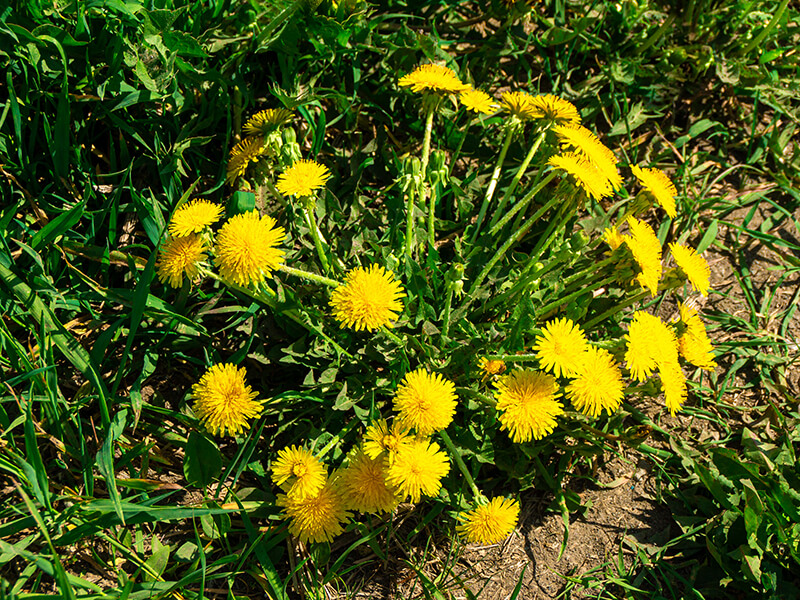
- 🔮 Symbolism: Expressed love; exorcise spiritual entities
- 💧 Water needs: Drought tolerant
- 🪴 Soil needs: Rich, fertile, well-drained, acid to neutral
- 🌍 Growing zones: 3 to 10
- ☀️ Light needs: Full sun or part shade
- 🌱 Blooming season: May to October
This plant is found in yards, fields, prairies, roadsides, and disturbed soil. This plant is edible in salad form. Flowering time attracts butterflies and predatory insects like robber flies, assassin bugs, and bees. Teas from the flowers help thin blood when taken internally. Pests or Diseases are resistant. The brightly yellow flush-colored flowers are a sight between May and October. The conspicuous yellow blooms that begin in May last almost throughout the year.
16. Hilton Daisy (Gerbera Aurantiaca)
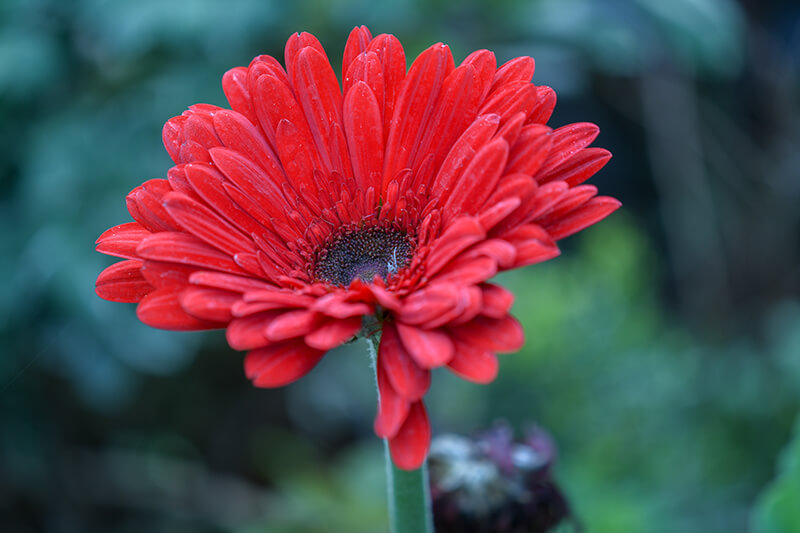
- 🔮 Symbolism: Bright and cheerful thoughts
- 💧 Water needs: Water regularly
- 🪴 Soil needs: Well-drained, moist, shallow
- 🌍 Growing zones: 3 to 11
- ☀️ Light needs: Full sun
- 🌱 Blooming season: September to November
The crimson, orange, pink, or yellow blooms are a cheerful sight. The luminous, showy petals on some silky branchlets can add color to a moment. Hilton Daisy is an endangered species, and the law prohibits the collection of its seeds. The images of daisy flowers of this kind show bright orange flowers that can be grown both indoors and outdoors. It adds color and vitality to the surroundings.
17. White Arctotis (Arctotis Stoechadifolia)
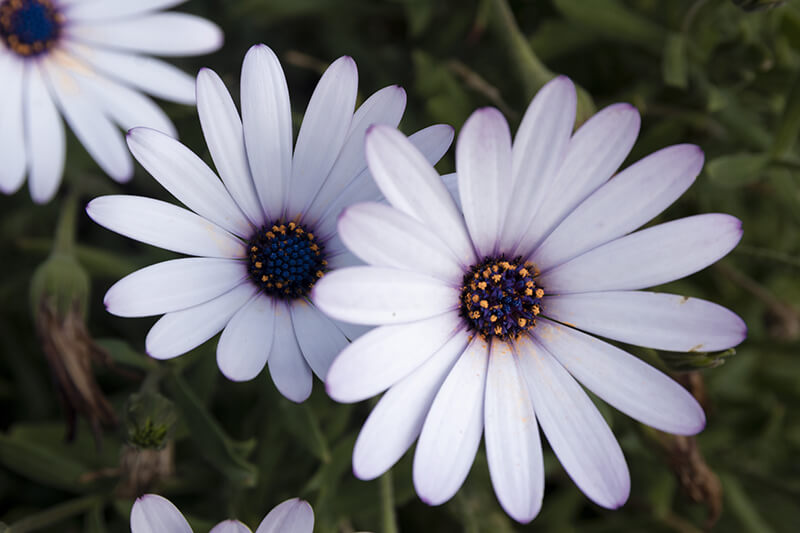
- 🔮 Symbolism: Cheerful endeavour
- 💧 Water needs: Low
- 🪴 Soil needs: Well-drained, dry, sandy
- 🌍 Growing zones: 8 to 11
- ☀️ Light needs: Full sun, dabbled shade
- 🌱 Blooming season: March to August
The white-colored flowering plant is an excellent ground cover. In addition, the velvety showy plant with luminous white flowers can be used for ornamental purposes. It makes lovely cut flowers too.
18. Double Feverfew (Tanacetum Parthenium ‘Flore Pleno’)
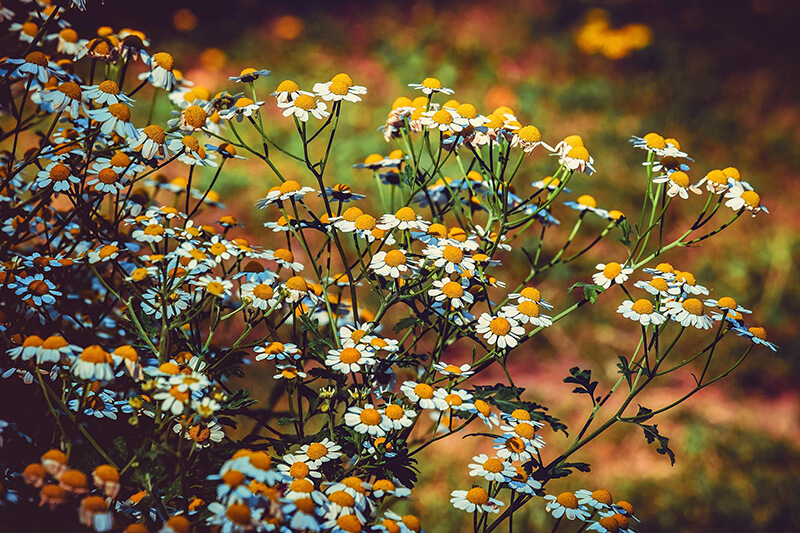
- 🔮 Symbolism: You light up my life
- 💧 Water needs: Average
- 🪴 Soil needs: Normal, sandy, clay, moist, Neutral, alkaline, acidic, free-draining
- 🌍 Growing zones: 4 to 8
- ☀️ Light needs: Full sun
- 🌱 Blooming season: July to September
The supple, stylish, and vibrant cultivar Tanacetum parthenium ‘Flore Pleno is a perennial herbaceous plant. It is most commonly cultivated for medicinal purposes. Double feverfew is used in the treatment of colds and migraines. The plant is an excellent insect repellant. Plant it along borders to deter insects from accessing your garden. It would be best to harvest its leaves in summer.
19. Golden Tansy (Tanacetum Vulgare)
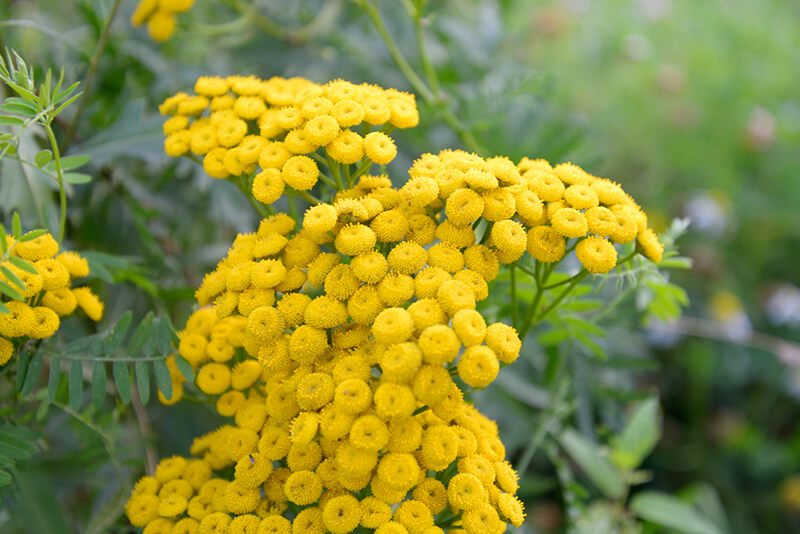
- 🔮 Symbolism: Protection, health, resistance, and immortality
- 💧 Water needs: Low to medium
- 🪴 Soil needs: Moist, well-drained with high organic matter
- 🌍 Growing zones: 4 to 8
- ☀️ Light needs: Full sun, partial shade
- 🌱 Blooming season: July to August
The bright, chic, regal, and radiant yellow flowers are majorly used for cottage gardens or naturalized areas. Furthermore, its young leaves-raw or cooked can be added to salads. The plant also substitutes nutmeg as a flavoring. Flowers are eaten or used as a garnish. A bitter, somewhat lemon-flavored tea is made from the leaves and flowering stems.
20. Mojave Desert Star (Monoptilon Bellioides)
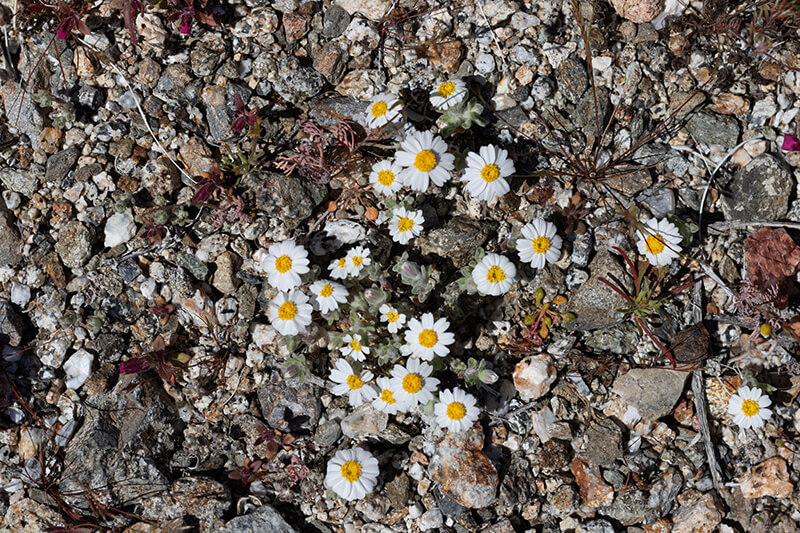
- 🔮 Symbolism: New beginnings, hope, innocence, fun, affection
- 💧 Water needs: Low
- 🪴 Soil needs: Dry, sandy, alkaline, mild acidic
- 🌍 Growing zones: 9 to 10
- ☀️ Light needs: Full sun
- 🌱 Blooming season: January to May
White, rose-tinged Mojave Desert star flowers prefer slopes, rocky outcroppings, and elevated areas. These grass-like flowers bloom two to four inches long stems during their initial stage. They carry inflorescences which consist of bilaterally symmetrical anthers that are equal spheres borne on level stalks or sometimes steeply erect. The anthers are contained in dense spherical clusters with moderate to thick spreading hairy subtended bracts and numerous leaves packed closely on short branchlets. Early Spanish explorers called this plant “Bello Nido,” meaning “beautiful nursery.” Besides using the seeds for eating, Navajo Indians employed the plant sap as an adhesive sealant on baskets, sandals, and other materials used as household goods. Young stems and leaves are cooked as greens. Modern healers use infusions of the roots to treat depression and anxiety.
21. Indian Chrysanthemum (Chrysanthemum Indicum)
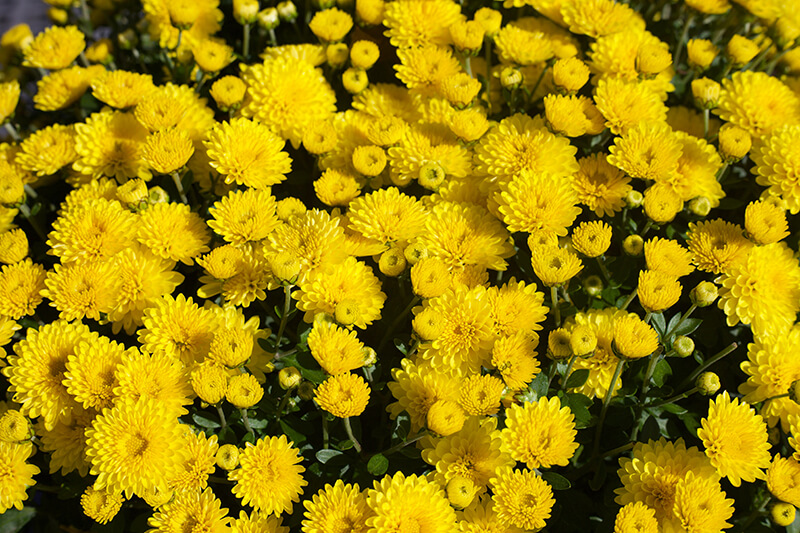
- 🔮 Symbolism: Innocence and purity
- 💧 Water needs: Moderate
- 🪴 Soil needs: Moist, well-drained, acid, alkaline, neutral, light
- 🌍 Growing zones: 7 to 12
- ☀️ Light needs: Full sun
- 🌱 Blooming season: March to October
Indian Chrysanthemum is a must-have plant for everyone who loves herbal teas. The plant is harvested for both food and medicinal purposes. Additionally, you can grow the plant for aesthetic value. The full bloom, heavenly, eye-catching red, yellow and flowers portray simple and wild grandeur. Apart from coloring your gardens, plant the flowers in pots and enjoy their dazzling colors indoors. Images of daisy flowers of this family show brightly yellow-colored flowers that are succulent.
22. Florist Daisy (Chrysanthemum Morifolium)
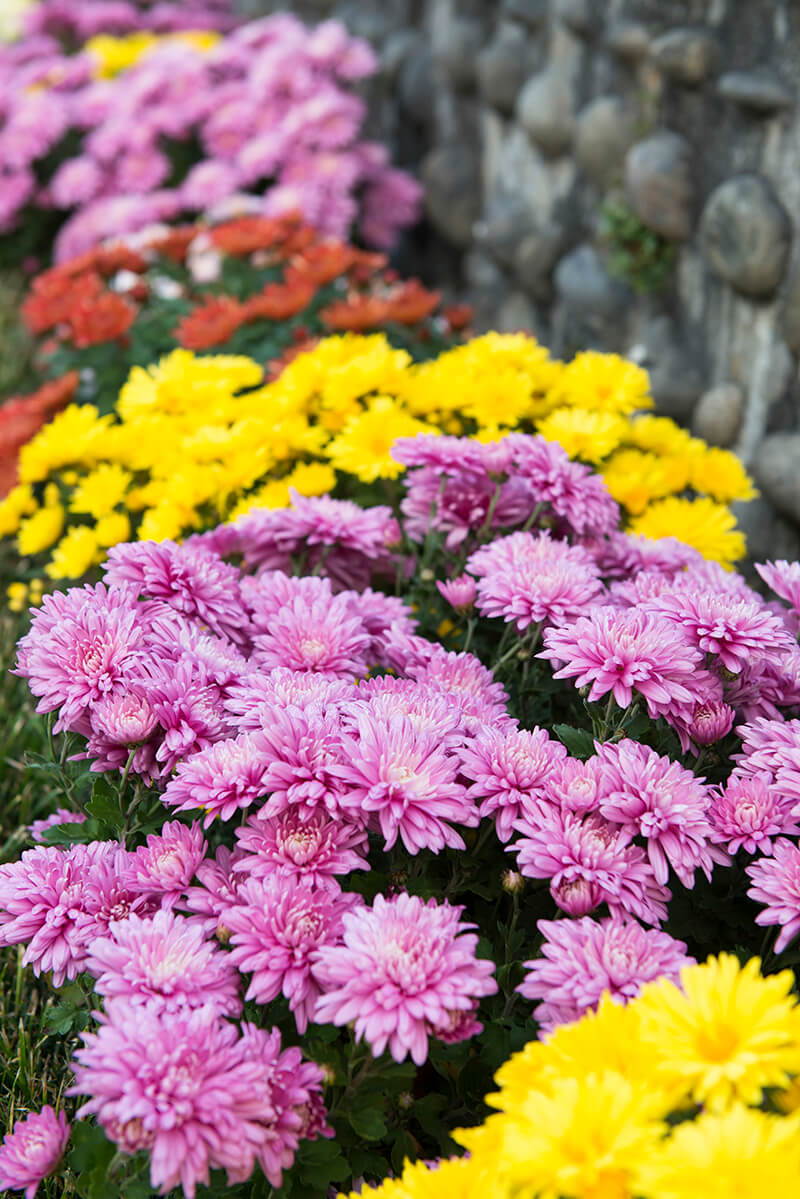
- 🔮 Symbolism: Happiness, love, longevity, and joy
- 💧 Water needs: Regular watering
- 🪴 Soil needs: Moist, acidic, fertile, well-drained, sandy or loamy
- 🌍 Growing zones: 2 to 12
- ☀️ Light needs: Full sun
- 🌱 Blooming season: June to November
Chrysanthemum morifolium is a flowering houseplant. Its orange, yellow, pink, red, white, and purple botanical and artful flowers are breathtaking. Perhaps the most famous plant is accessible for giving dependable blossoms to appreciate inside or on yards and porches. They are frequently sold as a gift plant since they are so natural to focus on.
23. Showy Townsend Daisy (Townsendia Florifer)
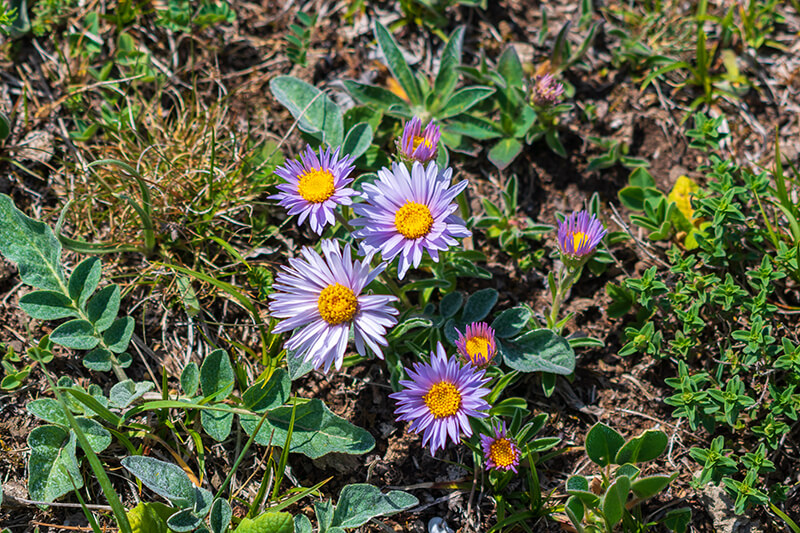
- 🔮 Symbolism: Childhood innocence, simplicity and joy
- 💧 Water needs: Low
- 🪴 Soil needs: Moist, well-drained
- 🌍 Growing zones: 3 to 9
- ☀️ Light needs: Full, dappled shade
- 🌱 Blooming season: April to August
This daisy flower plant is recognized by its profuse blooms, silver stamens, and white banner petals with a deep green pentagonal leaf, Townsend Daisy is an intelligent blossom to suggests an indoor plant. Simple maintenance and sterile soil will keep these easy-to-live dandies bringing flowers all through the spring. Presently showy and charming, this tough perennial never needs mulling over during the fall since they develop and recover rapidly.
24. Marguerite ‘Golden Butterfly’ (Argyranthemum Frutescens’ Golden Butterfly’)
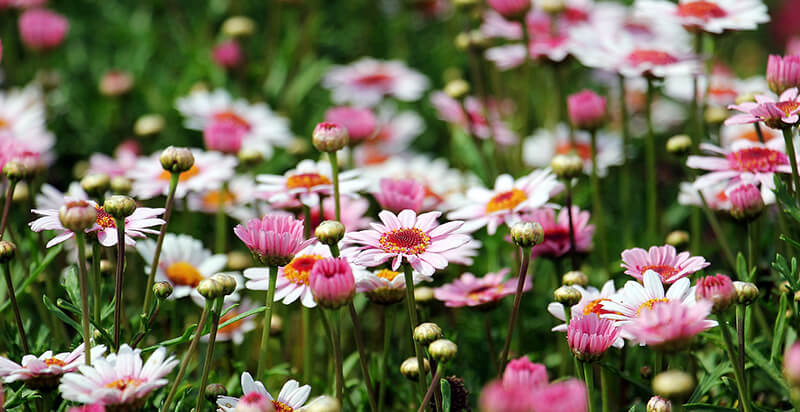
- 🔮 Symbolism: Faith, cheer, simplicity, loyal love
- 💧 Water needs: Low, average
- 🪴 Soil needs: Moist, well-drained, acid, alkaline, neutral
- 🌍 Growing zones: 10 to 11
- ☀️ Light needs: Full, dappled shade
- 🌱 Blooming season: Spring, early summer
The showy brightly Yellow assorted, blossom-filled, flowers are an excellent potted plant. They can also be planted in lawns and gardens for grandeur.
25. Coneflower ‘PowWow Wild Berry’ (Echinacea Pursuer)
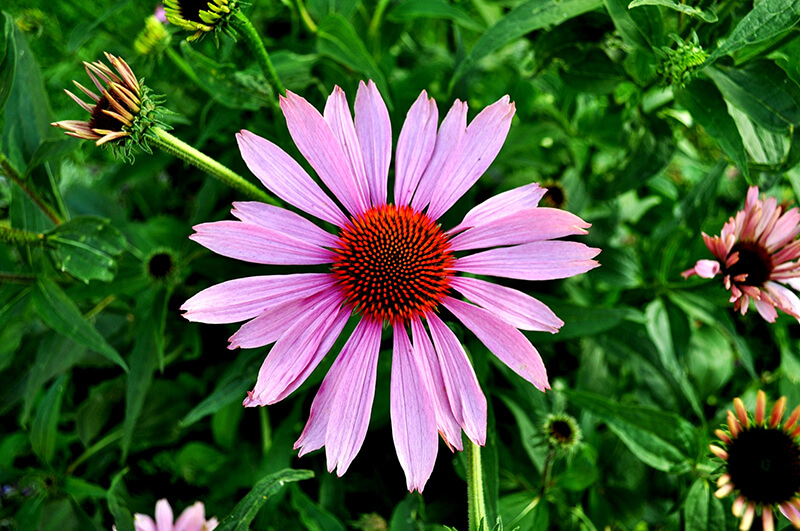
- 🔮 Symbolism: Strength and healing
- 💧 Water needs: Low
- 🪴 Soil needs: Well-drained, acid, alkaline, neutral
- 🌍 Growing zones: 3 to 8
- ☀️ Light needs: Full sun, partial shade
- 🌱 Blooming season: June to August
Echinacea Pursuer’ Powwow Wild Berry’ is an enormous, flashy, profound rose purple blossoms on broad, strong, all-around expanded stems. Prevalent execution remembering a basal expanding propensity that outcomes for other blooms per plant. It draws in numerous hummingbirds and butterflies and is utilized therapeutically as a concentrate or homegrown tea. The flowers are suitable for both indoor and outdoor planting.
26. Cheyenne Spirit’ Coneflower (Echinacea’ Cheyenne Spirit’)
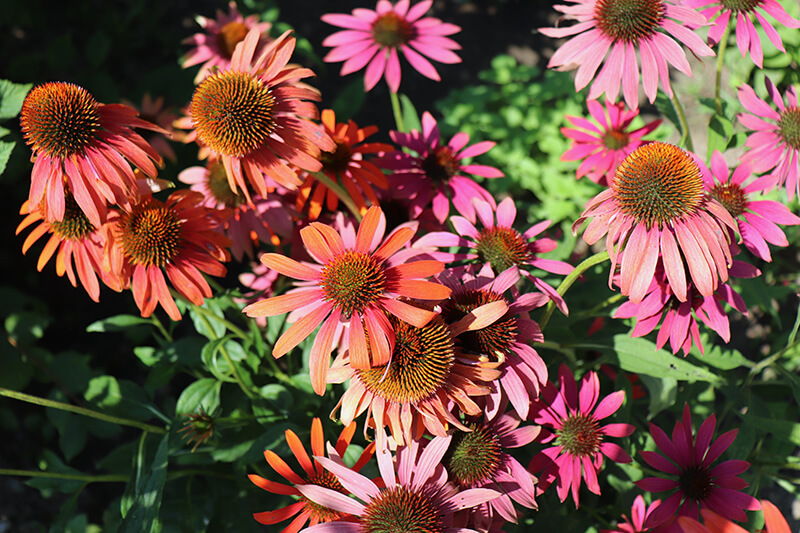
- 🔮 Symbolism: Strength and healing
- 💧 Water needs: Low or average
- 🪴 Soil needs: Well-drained, neutral, alkaline, acidic, chalk, loam, sand
- 🌍 Growing zones: 5 to 9
- ☀️ Light needs: Full sun
- 🌱 Blooming season: June to August
Cheyenne Spirit Coneflower is a unique and perfect choice for beds and borders, prairies, Wildflower gardens, and cottage gardens. The flashy light yellow to dark red flowers are excellent as cut flowers. Although deer resistance, they attract humming buds, bees, butterflies, and other pollinators. Plant these flowers from spring till fall to enjoy them during the whole year. The native Americans used it to cure wounds and infections.
27. Monarch-of-the-Veld (Arctotis Fastuosa)
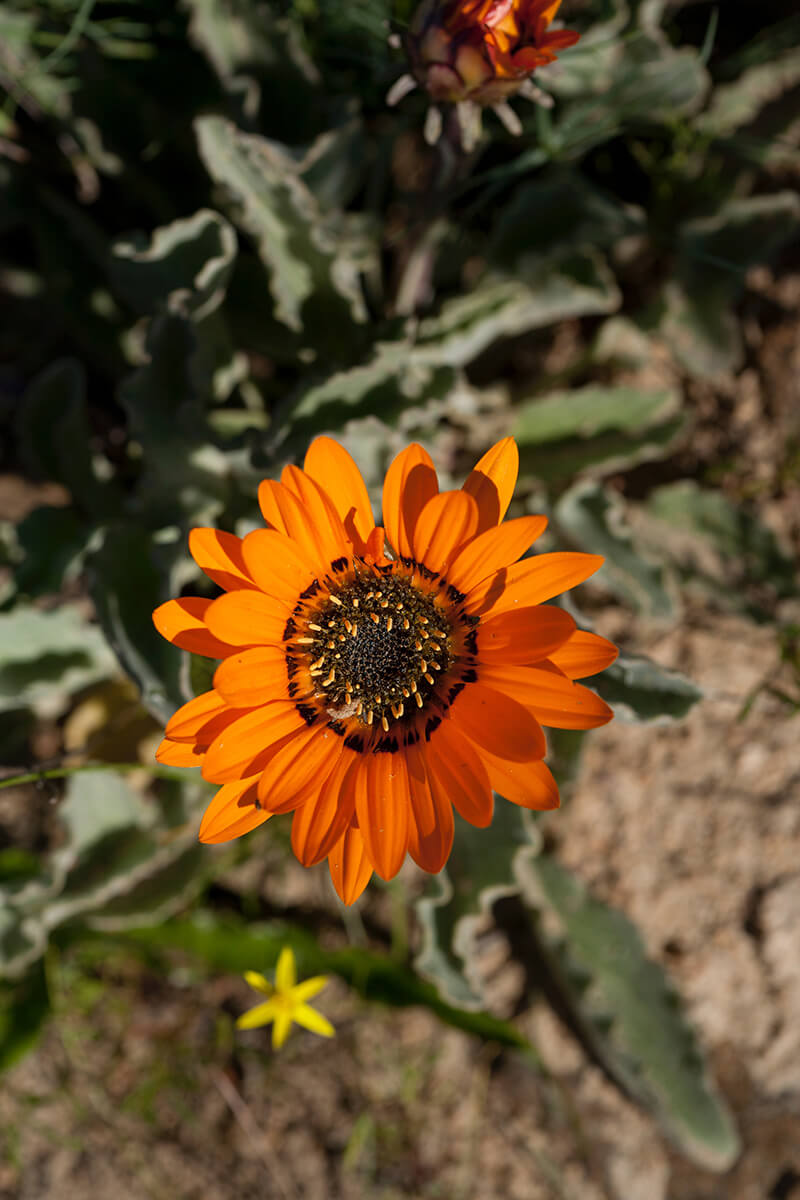
- 🔮 Symbolism: Grandeur, fidelity, and good respect
- 💧 Water needs: Regular
- 🪴 Soil needs: Rich, well-drained
- 🌍 Growing zones: 4 to 11
- ☀️ Light needs: Full sun
- 🌱 Blooming season: Spring through fall
Monarch-of-the-Veld (Arctotis Fastuosa) flowers are unique and thus grown for ornamental and floristry uses. They cannot be indoor plants. The plant’s yellow, white, purple, orange, and black clustered and jewel-toned flowers are a sparkle. These birds’ nesting weeds can be found mainly in South Africa. Some wildlife gardeners will plant them to attract wildlife to their garden and back aviary species like warblers who love to feed on their nectar. They are perennial plants but may die in winter if no extension is given.
27 Showy Richly Colored Awesome Daisies to Make your House and Garden a Paradise
Daisy flowers’ exotic, lush, chic, and artful appearances make them idyllic. While a few daises only offer eye candy, others have a musky scent. It is imperative to plant two or more daises together for an exotic, artistic appearance. There are different type of Daisy flower plants. Their planting and care are straightforward. While some daisy flowers are edible and can be used for medicinal purposes, others are toxic and purely for cosmetic issues They have been with us, pleasing the eye and nose Grow your different types of daisy flowers, and you surely won’t regret it. If you are looking for something that draws attention more, make sure to take a look at these types of evergreen trees.

